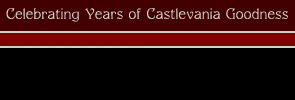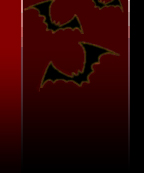|
Castlevania: Portrait of Ruin (2006)

Castlevania: Dawn of Sorrow, the first game released for Nintendo's DS and successor to Aria of Sorrow for the GBA, was a damned fine game. The problem was, the Metrovania formula was beginning to feel a little bit worn. The levels were all things we'd seen before; the bosses were almost all recycled, and more than a bit dull. Even the item collection and equipment system was exactly the same as the previous game. It was one of the most refined games in the series, and therefore technically the best, but outside of the final levels, there was a whole "been there, done that" aura that permeated throughout the entire game. Thankfully, Portrait of Ruin has finally arrived to inject some much needed fresh blood in the series.
Much like Symphony of the Night was the storyline sequel to Dracula X, Portrait of Ruin takes place a few decades after Castlevania Bloodlines. As faithful gamers recall, Bloodlines was the first attempt for Konami to tie in the series with the Bram Stoker's Dracula novel, and even though it didn't quite make sense, it did succeed by introducing a variety of levels that hadn't been seen in any other Castlevania game. Instead of just fighting through the Transylvanian countryside, John Morris and Eric Lecarde traveled through Europe, fighting evil which occasionally happened to take the form of skeletons wearing German helmets. It's up to hero Jonathan Morris (son of John) and his companion Charlotte Aulin to fight the evil count Brauner and his two vampiric daughters.
Dawn of Sorrow ditched the luscious Ayami Kojima in favor of standard anime stylings, which aggravated more than its share of fans. Portrait of Ruin plays the same card, although the artwork is significantly better. There's a lot of lighthearted humor that plays behind the story, which may dishearten fans that like their horror dark and only dark, but the fact that the writing isn't extremely embarrassing is already a step in the right direction for the series. The plot is actually pretty good, once you get into it, at least for a Castlevania game. It's interesting how much Johnny looks like the sprite of the hero apparently designed for the cancelled 32X game, at least with the red vest. The in-game graphics are about on par with Dawn of Sorrow, although there's a wider use of colors due to the wide variety of areas.

The dual hero system is one of Portrait's most interesting features. Johnny carries a whip like all of the Belmonts, although there's tons of other weapons, like the usual swords, maces and axes. You begin the game with the Vampire Killer whip, although since Jonathan can't use it properly, you'll quickly ditch it for something - anything - better. One of the coolest whips is the Nebula, which actually homes in on enemies without needing to jump.
Jonathan also attacks with collected subweapons like his predecessors, which include axes, daggers, boomerangs, grenades and other power-ups. All of these can be powered up with multiple uses, although this isn't really all that useful. On the other hand, Charlotte wields a variety of magical attacks. Her main weapon is a book which attacks with different spirits - at one point, you get one named "Don Quixote", where you stab foes with the image of a Spanish knight on a horse. You can also equip sub spells which includes your usual array of fire and ice spells, as well as stat boosts. Although the Soul System from Aria/Dawn is technically gone, certain enemies will randomly drop various spells that let you use similar attacks (so you can summon skeletons, for example.) There are also special team-up attacks with drain a ton of magic but can deal a lot of damage if used properly.
You can switch between characters at any time, as both share the same life bar, or
choose to have both on screen at once. With both characters, you control one and the other essentially shadows your movements, although they're governed by a simple AI so they'll still attack on their own. Although your partner can't actually take damage, they drain magic whenever they get hit, so you have to decide whether the extra helping hand is worth giving up your subweapons or spells. Usually it is, of course, especially if you can find ways to surround bosses and attack from both angles. Naturally, there are a few puzzles that take advantage of the dual hero system, none of which (so far) are particularly taxing. At one point, there are two motorcycles on separate tracks. You need to stick one character on each bike, then switch back and forth between characters to duck or jump over stuff. Sometimes you'll find that Charlotte is better at dealing damage to certain types of monsters, so it's to your advantage to switch between them when the need arises. In the fight against the Egyptian queen Astarte, her charm spell will cause Jonathan to lose his mind (and essentially causing you to lose the fight) unless you switch to Charlotte, where the seductive spell passes harmlessly through her.
There is still your standard Castlevania-style castle (suitably dubbed the "Akumajou" or "Demon Castle" in the Japanese version), filled with your standard entry hallway, standard underground passage, standard clock tower. But this huge map also acts as a hub to several other stages, which have their own maps and more huge territory to explore. You'll find yourself wandering through the foggy streets of London, in an Egyptian pyramid, and a mansion in the midst of a forest. Even crazier is one level dubbed "The Nation of Fools", which is a combination of the fun house level from Dawn of Sorrow, the Chaos stage from Aria of Sorrow, and the upside-down castle from Symphony of the Night. Parts of the stage are turned sideways - the top is completely topsy turvy. And not just the terrain is flipped either - the enemies are oriented with the stage, requiring you to fight Fleaman on the ceiling.
So yeah, the game is pretty huge. The boss monsters are also a bit more difficult than most gamers might be used to. None of them are overwhelming, but if you don't immediately figure out their patterns, you'll get crushed real quick, because they deal a lot of damage. Much like Aria, Dawn and Symphony, you get the bad ending if you rush into a certain boss battle too quickly. Once you figure out the proper way to win, you get to fight through four alternate versions of each the paintings. They're similar to the levels you've visited before, but reversed, drastically reworked with different areas, new enemies, new music, and different graphics. At the end of each of these, you'll fight classic Castlevania bosses like Frankstein's Monster and the Wolfman. It's essentially like the upside down castle from Symphony, but less sloppy. While the entire game world is far, far bigger than any other Castlevania game, it somehow doesn't really feel any longer. You can still beat the game and get the best ending in about six hours on your first time through.
That's not to say there isn't much to see and do. Part of this comes from the "quests" which are doled out by a ghostly guy named "Wind". Most of these involve accomplishing specific tasks (retrieve some meat from the butcher shop, for example), and usually get your exclusive items. Once you beat the game, there are plenty of alternate characters to play as, seven altogether. In each of the status screens, there's a little percentage marker to indicates how many quests you need to complete, items you need to upgrade, all kinds of facets of exploration. It's the sort of thing that keep obsessive compulsives busy for weeks, especially with the hidden final area, which is similar to the Colisseum from Circle of the Moon.
For as much as Konami has added this time, there's still a fair bit of retreaded territory - a couple of really old faces, like the rock monsters from Dracula X. And the Dogether, that floating eyeball thing. And you get to fight Legion. Again. And Konami, goddammit, how old is that Medusa sprite? How many frames is it? Is that THAT hard to redraw? But for every moment of relative laziness, there are at least several more to make up for it. As mentioned before, you get to fight a diminutive boss that kind of resembles Cleopatra, along with monsters with Sphinx masks. One enemies is a crazy looking monster that aims laser sights that reflect off the floor to show you the trajectory of their bullets.
A strange looking gentleman will attack Johnny on sight but give bouquets of roses to Charlotte. The zombie maids from the previous games return wielding vacuum cleaners, who temporarily disable Johnny by getting his butt stuck, or Charlotte by blowing up her skirt. When you close the DS lid, you hear a coffin lid slamming before the game enters sleep mode. Charlotte rides on a broom during a double jump. And then there's the bartender skeleton, or the weird ghost that disappears in the bathroom. Like all of the other recent Castlevania, there's a ton of cool touches and easter eggs hidden throughout.
Much like Dawn, there are a few hidden modes unlock after you beat the game. You can play as the vampire sisters, Stella and Loretta, which actually gives some use to the touch screen on the DS. Since the duo can fly, they're controlled solely with the directional pad, and attack with the stylus. You can use one of them to scribble out enemies to deal damage - the other will shoot ice bullets wherever you tap. The only thing to watch out for is the magic meter, which depletes while attacking of flying. There's also a Richter/Maria mode, where you can play as the heroes of Dracula X. The final unlockable mode, the Axe Armor mode, is just as lame as it was in Symphony. The Hard difficulty setting lets you put a level cap on your characters, forcing you to rely on reflexes rather than statistics. There are also three boss rush modes, which include a ton of foes from Dawn of Sorrow. This is the only mode which you can play over wireless co-op, although you can also set up stores via the internet to sell items to other players.
And the music? It's the best soundtrack to a portable Castlevania thus far. It's much closer to Aria of Sorrow in style, but faster paced and with higher quality samples. Though Michiru Yamane has composed most of it, many of the strongest tunes have been contributed by legendary video game musician Yuzo Koshiro. In addition to emulating the feel of older Castlevania games, there are ton of remixed songs, including Cross Your Heart (from Haunted Castle, although translated in the sound test as "Crucifix Held Close"), Iron Blue Intention (from Castlevania Bloodlines) and The Theme of Simon (from Super Castlevania 4), which is a hidden bonus song.
The only potential problem with Portrait of Ruin lies in the level design, which has been accused of being boring and samey. In all truth, they're about the same quality as all of the Metrovania games - if the previous entries bored you, Portrait isn't likely to change your mind. But everything about the game is far more inspired than its predecessors, from the settings to the story and especially to the music - makes this the finest portable Castlevania yet, and the best Metrovania since Symphony.
Portrait of Ruin Artwork

Back to Top
Castlevania Games - Castlevania: Portrait of Ruin
|
|
|



